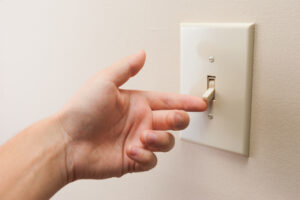
[From the last episode: We looked in more depth at voltageVoltage is what gets electrons to flow. It's analogous to water pressure, which gets water to flow. Voltage is measured in units of "volts." and currentThe amount of electrical flow. Measured in amperes or amps (A)., and that the direction that electronsA fundamental particle found outside atoms. It carries a negative charge. It can move easily in a conducting material, which gives rise to electrical current. flow is actually opposite to the direction that current is said to go.]
We saw before that voltage is like potential energy. As long as there’s no current, that energy remains potential. Once you give current a path across that potential, then you actually start doing work and dissipating some of that energy. So, when it comes to powerThe rate of energy consumption. For electricity, it’s measured in watts (W)., current is almost everything. I say “almost” because, yeah, the higher the voltage, the higher the power. But without any current whatsoever, there’s no power. But there’s also no work being done.
Transistors are the workhorses of our circuits, and we’re going to look at a couple of different kinds – and see why we changed transistors over 30 years ago.
All About Transistors
First of all, what is a transistor? You can think of it as a switch, loosely speaking. You have a current path from “top” to “bottom,” and you turn that path on using a third signal – like a light switch.*
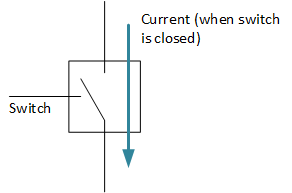
But details matter here. The first transistor that found its way into common use was the bipolar junction transistor, or BJT. The current path was from what was called the collector to the emitter; the switch was called the base. The challenge with this transistor is that it is fundamentally current-based: if there’s no current, there’s no work.
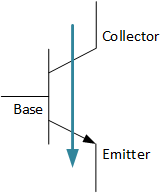
A different transistor then emerged, called a metal-oxide-silicon, or MOS transistor (technically, MOS field-effect transistor, or MOSFET). It works similarly, with different names for the signals. Current goes from drain to source**, and the switch is called the gate.

The key here is that it’s not current that drives this, but rather voltage (it’s that “field” thing – there’s a voltage across an electric field). So it will operate whether or not there’s current.
The other key here is that MOSFETs come in two opposing versions: n-type (NMOS) and p-type (PMOS). We won’t go into the difference, but here’s the essence: to turn on an NMOS device, you make the gate go high; to turn on a PMOS device, you make the gate go low. That’s super important.
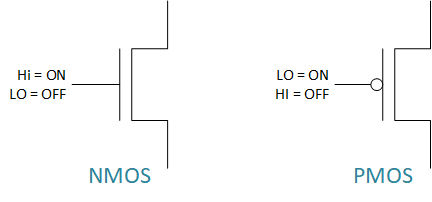
Hooking Those Transistors Up
With a BJT, you would typically have a load of some sort between power and the collector. When the transistor was on, you’d get current, and that current would cause a voltage across the resistor (remember Ohm’s Law?). That’s how you could tell whether the thing was on or off – by measuring the voltage*** on the collector. If there was no current, then that voltage would be the same as the supply voltage; if there was current, it would be lower.
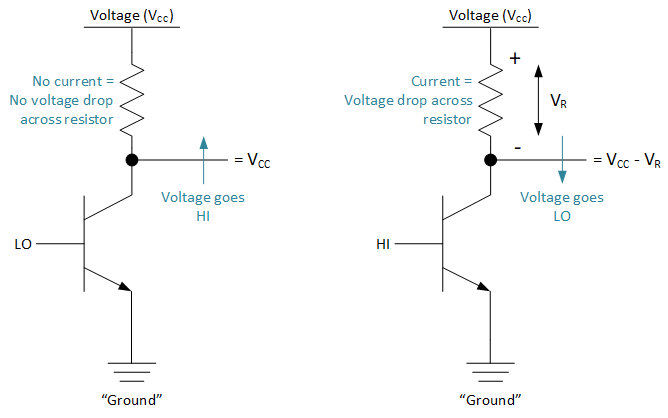
Here’s the important thing about this, however: when the BJT is on, then the current simply runs through the device, even if it’s just sitting there in the ON stateA broad term that can apply to a lot of systems. Let’s say you have a system that can be one of two ways – on or off. That “on-ness” or “off-ness” is the state of the system. The system is either in an on state or an off state. Many different kinds of systems can have many different kinds of state. There are many complex branches of engineering or physics or even mathematics that deal with state. The easiest way to think of any of them is, “the way things are” (which may depend on the history of prior states, meaning how they got to this particular state).. It’s kind of like a car that’s idling while stopped – it’s burning energy, but not doing anything useful except sitting there.
You could do the same thing with an NMOS transistor – in fact, that’s how MOS transistors were first used. But here’s the super clever thing: instead of just putting a resistor up there, you can put a PMOS device up there instead and connect the gates together. Now, when the gate goes high, the NMOS turns on – but the PMOS turns off. When the gate goes low, the NMOS turns off, but the PMOS turns on. Because these two transistors work in a complementary – or opposite – fashion, this is referred to as complementary MOS, or CMOSA way of connecting MOS (metal-oxide-semiconductor) transistors into a switch that conducts no current when sitting idle.. And CMOS has revolutionized circuits.
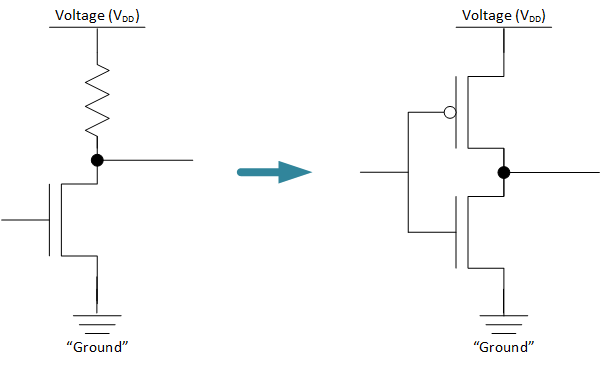
Look Ma! No Static Power!
Here’s the reason: whether the gate is high or low, only one transistor is on. In order to have current, you need both transistors to be on – and that doesn’t happen except for one situation: when the gate is switching from one state to the other.
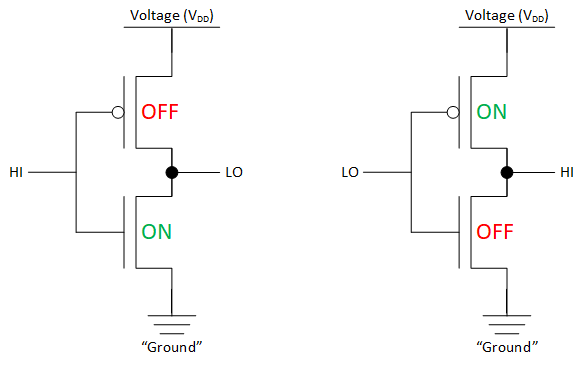
But when just sitting there, as long as nothing is switching, there is no current (to a first approximation – we’ll look more at this in a couple of weeks). So, in this static condition, there is no power. That is, static powerThe rate of energy consumption of a circuit when nothing is switching -- it's just sitting idle. is zero.
Yeah, there are also two types of bipolar transistor, and, in theory, you could try to hook them up the same way. Heck, early in my career, when all of this was in transition, I racked my brain trying to think of ways to do a similar thing with bipolar. But smarter people than me already knew what I finally accepted: because bipolar transistors are current-based, it would never work. And so CMOS won the day.
Think of it this way: imagine a light switch that had a spring in it that made it want to stay on. To turn it off, you’d have to pull down and keep pulling on it or else the spring would turn it back on when you let go. It’s an imperfect analogy, but that’s what a BJT is like. With CMOS, you need energy to switch, but once you’ve switched it, you don’t need to keep “pulling” on it.
By the way: the input to the transistor (the base or gate)? That doesn’t contribute much of anything to current. With a BJT, the base definitely conducts current, but it’s not a lot. With a MOSFET, on the other hand, the gate doesn’t have a direct currentDirect current (which has constant voltage). This is what electronics require as an energy source. path (again, to a first approximation). So we don’t have to worry about current there.
Oh, and that thing about having current when the gate switches? That’s what we’ll look at next week.
Notes:
* You can also set the switch to partially on, and then put a signal on that switch – like a music signal. That signal, in “vibrating” the switch, will cause the current path to vibrate as well – only much more than the signal at the switch. This is the “analog” use of a transistor, famous as an amplifier – since it’s taking that small switch signal and turning it into a bigger signal in the current path.
**It may sound weird for current to go to the source instead of from the source – after all, it’s a source, right? Well, this gets to that direction-of-current thing. It is indeed the source of electrons, and they flow from the source to the drain – the opposite direction of how we say the current goes. I know, annoying… but it works.
***Note on the “voltage”: Because the voltage used to be connected to the collector of the BJT transistor (through a resistor), it was historically called VCC – a remnant name you’ll still see sometimes. With MOS transistors, that voltage goes to the drain rather than a collector, so it’s called VDD. There’s no fundamental difference other than that.

Leave a Reply